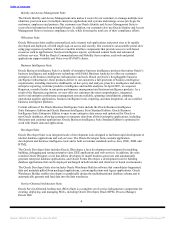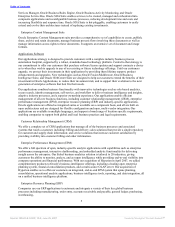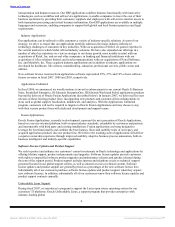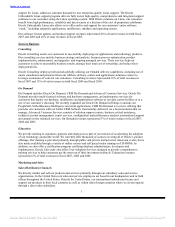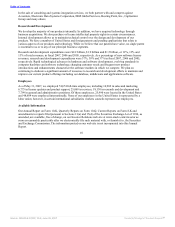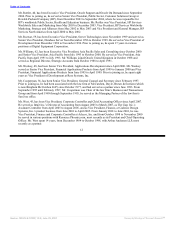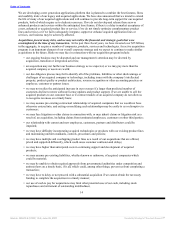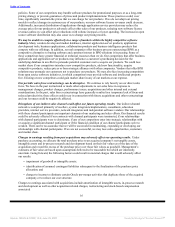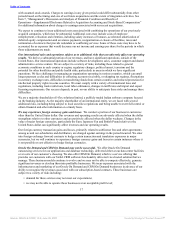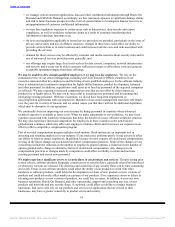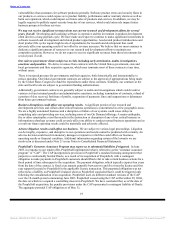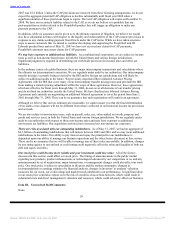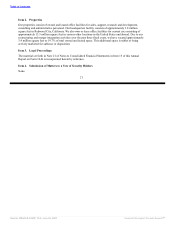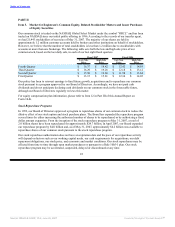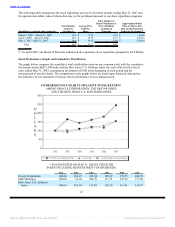Oracle 2006 Annual Report Download - page 18
Download and view the complete annual report
Please find page 18 of the 2006 Oracle annual report below. You can navigate through the pages in the report by either clicking on the pages listed below, or by using the keyword search tool below to find specific information within the annual report.
Table of Contents
We are developing a next generation applications platform that is planned to combine the best features, flows
and usability traits of our legacy and acquired applications. We have also announced that we intend to extend
the life of many of our acquired applications and will continue to provide long-term support for our acquired
products, both of which require us to dedicate resources. If we do not develop and release these new or
enhanced products and services within the anticipated time frames, if there is a delay in market acceptance of
a new, enhanced or acquired product line or service, if we do not timely optimize complementary product
lines and services or if we fail to adequately integrate, support or enhance acquired application lines or
services, our business may be adversely affected.
Acquisitions present many risks, and we may not realize the financial and strategic goals that were
contemplated at the time of any transaction. In the past three fiscal years, we have invested over $25 billion,
in the aggregate, to acquire a number of companies, products, services and technologies. An active acquisition
program is an important element of our overall corporate strategy and we expect to continue to make similar
acquisitions in the future. Risks we may face in connection with our acquisition program include:
• our ongoing business may be disrupted and our management’s attention may be diverted by
acquisition, transition or integration activities;
• an acquisition may not further our business strategy as we expected, or we may pay more than the
acquired company or assets are worth;
• our due diligence process may fail to identify all of the problems, liabilities or other shortcomings or
challenges of an acquired company or technology, including issues with the company’s intellectual
property, product quality or product architecture, revenue recognition or other accounting practices or
employee, customer or partner issues;
• we may not realize the anticipated increase in our revenues if a larger than predicted number of
customers decline to renew software license updates and product support, if we are unable to sell the
acquired products to our customer base or if contract models of an acquired company do not allow us
to recognize revenues on a timely basis;
• we may assume pre-existing contractual relationships of acquired companies that we would not have
otherwise entered into, and exiting or modifying such relationships may be costly to us or disruptive to
customers;
• we may face litigation or other claims in connection with, or may inherit claims or litigation risk as a
result of, an acquisition, including claims from terminated employees, customers or other third parties;
• our relationship with current and new employees, customers, partners and distributors could be
impaired;
• we may have difficulty incorporating acquired technologies or products with our existing product lines
and maintaining uniform standards, controls, procedures and policies;
• we may have multiple and overlapping product lines as a result of our acquisitions that are offered,
priced and supported differently, which could cause customer confusion and delays;
• we may have higher than anticipated costs in continuing support and development of acquired
products;
• we may assume pre-existing liabilities, whether known or unknown, of acquired companies which
could be material;
• we may be unable to obtain required approvals from governmental authorities under competition and
antitrust laws on a timely basis, if it all, which could, among other things, prevent us from completing a
transaction;
• we may have to delay or not proceed with a substantial acquisition if we cannot obtain the necessary
funding to complete the acquisition in a timely manner;
• our use of cash to pay for acquisitions may limit other potential uses of our cash, including stock
repurchases and retirement of outstanding indebtedness;
14
Source: ORACLE CORP, 10-K, June 29, 2007 Powered by Morningstar® Document Research℠


